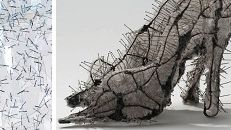
Press release -
Slow Art – lovingly crafted artworks at Nationalmuseum
10 May marks the start of Nationalmuseum’s Slow Art, an exhibition where technique, materials and painstaking processes take centre stage. The focus is on doing things well rather than quickly, on quality over quantity. The exhibition will present 30 or so works of applied art – all unique examples of superb craftsmanship.
Few people remain unmoved by things made with great care and attention to detail. In the old days, fine craftsmanship was much sought after. Since the industrialisation of the early 20th century, however, such skills have no longer been so highly valued. Instead, efficiency and time-saving processes have been the desired goal for many in modern Western society.
It can therefore be difficult to fathom why some people still choose to develop their artistic creativity by immersing themselves in one or more craft techniques. It might even feel a little frightening and provocative to some. After all, what is it that these artists achieve through their persistent, slow and often long-winded work, punctuated by repeated tasks that commonly lead to physical pain? What drives Renata Francescon to mould china clay into rose petals hour after hour, day after day? Why does Tore Svensson insist, year after year, on hammering bowls out of cold iron, even though his body can take no more than a couple of hours of such toil per day? What does Lotta Åström get out of coiling steel wire into a tight spiral that she then saws up into tiny, tiny rings, and then painstakingly solders together to make jewellery like chain mail?
There is no simple answer to these questions – just the knowledge that their goal is to do with more than financial gain through efficient production. They are driven by the satisfaction that individuals can achieve by challenging themselves on a profound level, putting their stamina and their technical skills to the test. A satisfaction that money just cannot buy. Perhaps these artists and craftspeople can be compared to the extreme adventurers who push themselves to the limit up mountains and across icy plains?
Slow Art is about a different perspective on time and manufacturing processes. With this concept, Nationalmuseum is celebrating a contemporary movement in the design world. In a society largely driven by short-term financial gain, the phenomena encompassed by the Slow concept indicate a conscious distancing from prevailing values and circumstances. The term has made its way into a number of modern movements, such as Slow Food (the opposite of Fast Food), Slow Travel, Slow Craft, Slow Design, Slow Fashion, Slow Media and Slow Consumption. People’s need to slow down and create space for reflection has been summarised under the banner of the Slow Movement. Its advocates speak up for an existence that is not driven by a constant battle against the clock, by financial profit and short-term buy-wear-discard consumption.
Like other Slow movements, Slow Art is a relatively marginal phenomenon. But it is interesting for the light that it sheds on our own existence. Slow Art is about doing things well rather than quickly, valuing quality over quantity. It is about treating materials – our shared natural resources – with care and thus also showing consideration for future generations. It is about seeing the value in slowness.
The Slow Art exhibition presents around 30 objects from the past three decades made in glass, ceramic, textiles, metal, wood and paper. Most of the works come from Nationalmuseum’s collection of applied art and design. The artists on show include Helena Hörstedt, Mafune Gonjo, Eva Hild, Helena Edman, Sebastian Schildt, Helena Sandström, Annika Ekdahl, Pasi Välimaa and Karen Bit Vejle.
The exhibition runs from 10 May 2012 to 20 January 2013.
Catalogue
The exhibition is accompanied by a catalogue, written by exhibition curator Cilla Robach and designed by Ida Wessel. The catalogue will also be available to everyone on the Nationalmuseum website for the duration of the exhibition.
Further information
Cilla Robach, exhibition curator, cilla.robach@nationalmuseum.se, +46 8 5195 4388
Hanna Tottmar, press officer, hanna.tottmar@nationalmuseum.se, +46 8 5195 4390, +46 767 23 46 32
Press images
www.nationalmuseum.se/pressroom
Captions
Renata Francescon, Sub Rosa, 2004; Mafune Gonjo, Beauty has a thorn, 2010; Annika Liljedahl, Sleeping Beauty, 2005.

